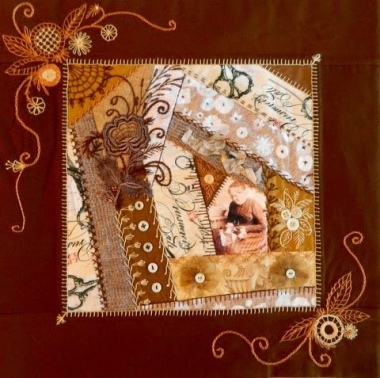Crazy Quilts
Crazy Quilts are decorative quilts often composed with blocks made from a wide variety of fabrics, cut in shapes stitched to a foundation block and embellished with hand embroidery. Crazy Quilts were most often made in the Victorian era, starting after the 1876 Philidelphia Centennial Exposition. The most popular exibit was from Japan and featured asymmetrical art and cracked glazed ceramics. Women were excited to incorporate this new look into their quilts and women's magazines helped to make Crazy Quilts all the rage. These show piece quilts were made unquilted and used as decoration anda as lap robes. Decorative fabrics such as silks, velvets and brocades from clothing of the day, were incorporated with campaign ribbons and other memorabilia from the times. Crazy was not ment to be wild, but to emulate the cracked glaze of the Japanese pottery, so the fabric was in pieces! These quilts gave the quilter a chance to show off their imagination and embroidery skills. Crazy quilts were used as fund raisers and included a piece of fabric from famous people. After 1900 Crazy Quilts began to appear made from wool, flannel, denims and other cotton fabrics and were more utilitarian than decorative.
The silk used in the Antique Crazy Quilts was made with metals to make them heavy and rustle and dyes that have caused the silk to rapidly deteriorate. If you are fortunate and have one of these amazing quilts take the time to research quilt preservation techniques and options.
Benefits of Crazy Quilts
- Crazy Quilts can be made from small pieces of fabric, allowing the maker to use many leftover fabrics.
- The use of fancy embroidery stitches is common on fine Crazy Quilts, many of which were made from fabrics such as velvet, silk, and other high-end materials.
- Crazy Quilts can be faster to make than traditional quilts as they do not have traditional quilting stitches. Once complete, the top layer is usually secured to a backing with ties, made from yarn, heavy thread, or ribbons.
- Batting is rarely used on a Crazy Quilt as they are decorative items for the home, not bedding designed for warmth.
Supplies and Tools for Crazy Quilts
- Fine fabrics are common in Crazy Quilts and may come from remnants from garment-making. Velvet, silk, brocade, and other decorative fabrics add to the elegance often seen in early Crazy Quilts.
- Embroidery, simple or elaborate, is often used to decorate the seams where fabrics are joined to each other. The higher the skill of the maker, the more elaborate the designs. The embroidery for today's Crazy Quilt can be machine embroidery.
- Symbolism is often seen in Crazy Quilts--animals, insects, monograms, human figures, flowers, just about any design may appear in Crazy Quilt embroidery. Favorite sayings are also embroidered on the blocks.
- When made from woolen and cotton fabrics, Crazy Quilts are often tied, and may not have embroidery. These are utilitarian and may be used as bedding. Swatch books of woolen fabrics used for men's clothing are resources for the wide variety of fabrics used in Crazy Quilts.
What I Wished I Knew When I Started making Crazy Quilts
When making CRAZY QUILTS, using small pieces of fabrics as a base for embroidery stitches is a good way to use up those favorite bits of fabric. The hand stitching of embroidery is relaxing and a good way to use moments of time otherwise lost.









